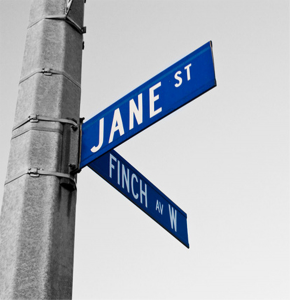
Osgoode Hall Law School is coincidentally located in very close proximity to one of Canada’s most “notorious” and “crime-ridden” locales. For many, the phrase “Jane and Finch” conjures notions of extreme poverty, drug abuse, gang violence, crime, and racialized identities, if not conceptions of even greater heinousness. It is a dangerous place, to be entered with caution and consideration, and only if complete avoidance is not viable. More problematic than the stigmatization of this demography as a whole is the unfounded and blanket attribution of related character and personality traits to its citizens. The people who live there are bad; they are criminals, they are dangerous. Without entering into an overly complex account of the causes of these misconceptions, they can be broadly deduced to arise from the following categories which work in tandem to amplify the result: political and economic strategy, criminological reporting and methodology, access to justice, and media propaganda.
Following the line of argumentation that asserts that “bad” people commit crimes (which is not the contention of this author), reality dictates that offences are committed everywhere, and thus, there must necessarily be “bad” people residing in all neighborhoods. As logical as this appears in black and white, it is easily taken for granted, if not completely discarded, when confronted with the powerful and persuasive tools used to convey the opposite. Dismantling the dominant rhetoric and flawed reasoning demonstrated in presentations connecting demography with frequency and type of crime is the focus here. For example, statistics can indicate the frequency of crime reporting per demographic area. When a correlation is found between frequency of reporting and location, presented with an adrenaline-pumping audio track and broadcasted for public consumption as breaking news in the aftermath of a violent crime in a so-called “ghetto,” it is often assumed, in absence of being told a concrete conviction rate, that criminals reside and abound in that neighbourhood. The stereotype is born. Moral panic and local hysteria often follow, perpetuating the vilification and othering of geographies and their inhabitants, all under the guide of an intricate politic of social regulation.
However, such a conclusion fails to take into account, among other pertinent considerations, the type of crime being reported. Assuming that drug, gang, and violent offences are most prevalent in this neighborhood, in what spatiality, for example, do white-collar or corporate crimes occur? Where do these classes of offenders reside? Is the perpetrator of a financial crime less culpable or morally blameworthy than one of a drug or violent offence? This is relevant as Jane and Finch, equipped with many affordable and government-assisted accommodation options, attracts immigrant and low-income populations. Conversely, it is probable that most individuals who commit white-collar crimes are employed in a professional capacity, are of mid to high socio-economic status, and reside in a correspondingly upper-class neighbourhood. Therefore, upon deconstruction, one can assert that serious crime happens everywhere and “bad” people live in both high and low income areas.
A secondary claim that seeks to posit the legitimacy of the erroneous perception that Jane and Finch is dangerous as it is filled with “bad” criminals is the notion that the frequency of offences being committed there is greater than that of other locations. Acknowledging that although this premise may be supported by crime statistics, this is not, in and of itself, determinative of validity. Beyond the scope of this piece, but nonetheless worth mentioning, is the impact that racial profiling and the knowledge of social factors that affect propensity to engage in criminal activity have on the actions of law enforcement. Furthermore, drug, gang, and violent crimes often occur in public places, whereas the majority of white-collar or financial offences commonly take place in privately owned businesses and residences which are less conducive to overt police detection. These pragmatic considerations in turn affect the statistical recording and evaluation of crime frequency.
A further point can be drawn from the example of an individual residing in upper-class Yorkville who commits the offence of possessing narcotics for the purpose of trafficking. Suppose that this results in one arrest, whereas the same quantity of narcotics, if distributed by this person, would result in hundreds of arrests for possession of the prohibited substance among drug users. The multiple possession offences are likely to take place in low-income areas, such as Jane and Finch, where accessible accommodation is available to those who require it, including individuals suffering from addictions and mental disorders. This begs the question regarding the relevance of frequency of crime if type and category (e.g. degree of seriousness) are not reciprocal considerations, and even if the aforementioned classifications are adequate concepts to rectify the nature of this disjunct? Therefore, it is evident that heightened crime reporting or incidences of arrest should not be conclusive indicators of a neighborhood’s character or the disposition of its residents.
To conclude, revitalizing common-sense: crime happens everywhere. It is not a centralized phenomenon, a drive away from the security and comfort of two-car driveways and private schools. Without fully critiquing the following statement, it’s safe to say that “bad” people are everywhere. Multi-institutional sensationalization of the correlation between crime and geography is a powerful and efficacious discursive tool unlikely to become extinct anytime soon. The practical effects of this are magnified discrimination, fear, and hatred. It is my hope that this effort to myth-bust some of the most blatant misconceptions of Jane and Finch and its citizens, instead of absent-mindedly internalizing media and popular representations, will lead readers to embark on a critical evaluation of the messages they choose to elevate to their personally-held beliefs. For those of us who have the fortunate opportunity of residing near or in this vibrant community, I urge you to proudly declare your postal code!
